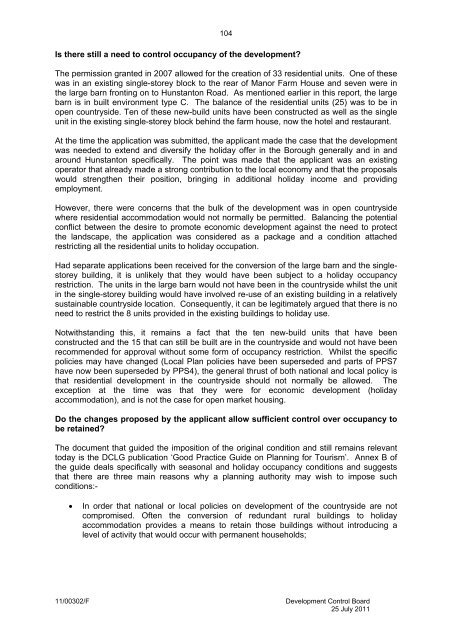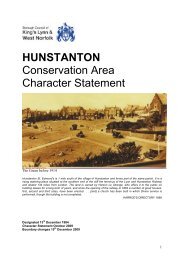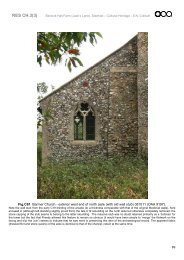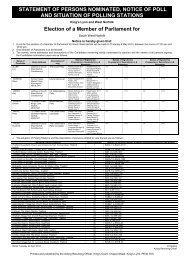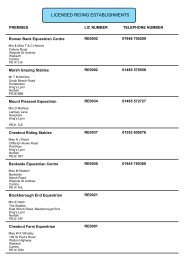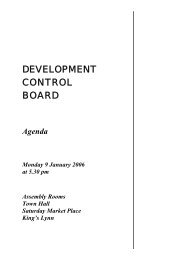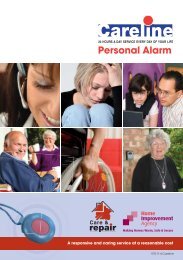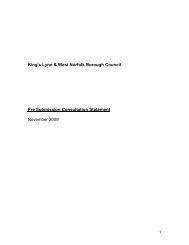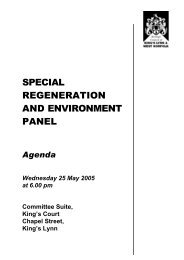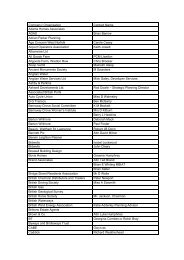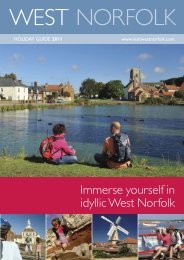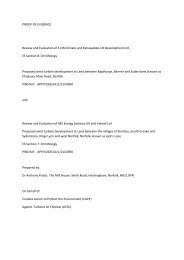11/00713/F - Borough Council of King's Lynn & West Norfolk
11/00713/F - Borough Council of King's Lynn & West Norfolk
11/00713/F - Borough Council of King's Lynn & West Norfolk
Create successful ePaper yourself
Turn your PDF publications into a flip-book with our unique Google optimized e-Paper software.
Is there still a need to control occupancy <strong>of</strong> the development?<br />
The permission granted in 2007 allowed for the creation <strong>of</strong> 33 residential units. One <strong>of</strong> these<br />
was in an existing single-storey block to the rear <strong>of</strong> Manor Farm House and seven were in<br />
the large barn fronting on to Hunstanton Road. As mentioned earlier in this report, the large<br />
barn is in built environment type C. The balance <strong>of</strong> the residential units (25) was to be in<br />
open countryside. Ten <strong>of</strong> these new-build units have been constructed as well as the single<br />
unit in the existing single-storey block behind the farm house, now the hotel and restaurant.<br />
At the time the application was submitted, the applicant made the case that the development<br />
was needed to extend and diversify the holiday <strong>of</strong>fer in the <strong>Borough</strong> generally and in and<br />
around Hunstanton specifically. The point was made that the applicant was an existing<br />
operator that already made a strong contribution to the local economy and that the proposals<br />
would strengthen their position, bringing in additional holiday income and providing<br />
employment.<br />
However, there were concerns that the bulk <strong>of</strong> the development was in open countryside<br />
where residential accommodation would not normally be permitted. Balancing the potential<br />
conflict between the desire to promote economic development against the need to protect<br />
the landscape, the application was considered as a package and a condition attached<br />
restricting all the residential units to holiday occupation.<br />
Had separate applications been received for the conversion <strong>of</strong> the large barn and the singlestorey<br />
building, it is unlikely that they would have been subject to a holiday occupancy<br />
restriction. The units in the large barn would not have been in the countryside whilst the unit<br />
in the single-storey building would have involved re-use <strong>of</strong> an existing building in a relatively<br />
sustainable countryside location. Consequently, it can be legitimately argued that there is no<br />
need to restrict the 8 units provided in the existing buildings to holiday use.<br />
Notwithstanding this, it remains a fact that the ten new-build units that have been<br />
constructed and the 15 that can still be built are in the countryside and would not have been<br />
recommended for approval without some form <strong>of</strong> occupancy restriction. Whilst the specific<br />
policies may have changed (Local Plan policies have been superseded and parts <strong>of</strong> PPS7<br />
have now been superseded by PPS4), the general thrust <strong>of</strong> both national and local policy is<br />
that residential development in the countryside should not normally be allowed. The<br />
exception at the time was that they were for economic development (holiday<br />
accommodation), and is not the case for open market housing.<br />
Do the changes proposed by the applicant allow sufficient control over occupancy to<br />
be retained?<br />
The document that guided the imposition <strong>of</strong> the original condition and still remains relevant<br />
today is the DCLG publication ‘Good Practice Guide on Planning for Tourism’. Annex B <strong>of</strong><br />
the guide deals specifically with seasonal and holiday occupancy conditions and suggests<br />
that there are three main reasons why a planning authority may wish to impose such<br />
conditions:-<br />
� In order that national or local policies on development <strong>of</strong> the countryside are not<br />
compromised. Often the conversion <strong>of</strong> redundant rural buildings to holiday<br />
accommodation provides a means to retain those buildings without introducing a<br />
level <strong>of</strong> activity that would occur with permanent households;<br />
<strong>11</strong>/00302/F Development Control Board<br />
25 July 20<strong>11</strong><br />
104


